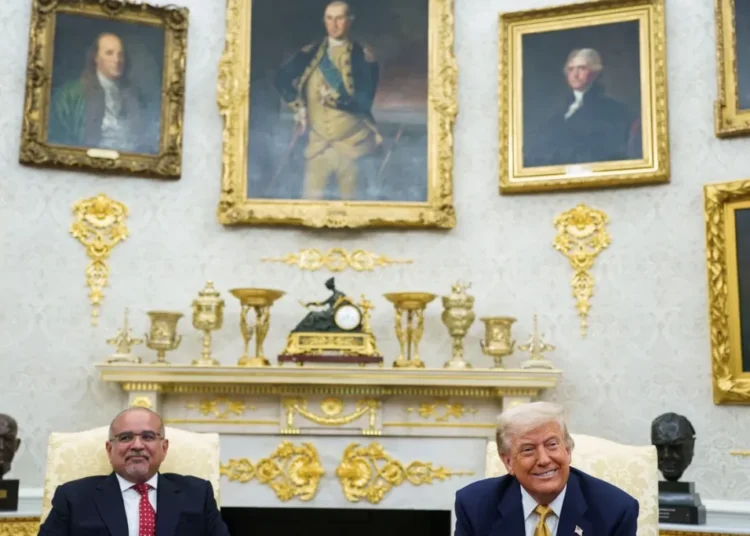The number of newly enrolled foreign college students in the United States dropped 17 percent this fall after the Trump administration made it more challenging to obtain student visas, data released Monday by the Institute of International Education shows.
The figures, based on a survey of more than 825 colleges and universities, provide one of the clearest views of the potential impact of measures President Donald Trump’s administration has taken that make it more difficult for foreign students to come to the U.S.
That effort has included restricting travel from 19 nations; pushing schools to limit the number of foreign students; temporarily pausing student visa screening interviews while the government revamped procedures to include tougher social media rules; and canceling visas for students accused of crimes, overstaying their visa or participating in pro-Palestinian protests.
The White House and Education Department did not respond Friday to requests for comment on the latest data, but an Education Department spokesman said in a statement earlier this month that colleges that receive taxpayer money should “prioritize expanding opportunities for American students.” The spokesman also said the administration wants to ensure that people who come to the United States to study “respect our laws, values, and national interests.”
Many experts expect the numbers will continue to fall next year as many foreigners decide to study in other countries instead. The number of international students applying to study at U.S. colleges next year has fallen 9 percent so far, according to data collected from students who applied using the Common Application by Nov. 1. The largest drops occurred among applicants from Asia and Africa. Domestic applicants rose 7 percent.
Some advocates argue the decline in new international students will ultimately hurt the U.S. economy because immigrants often play a key role in starting companies and working in research.
“International students aren’t just tuition revenue,” said Chris Glass, a Boston College professor and researcher on international higher education. “A decline in international students is not just a matter for next year’s enrollment cycle for universities — it’s a strategic setback for America’s role as a hub of global talent, science and innovation.”
Glass and others say universities depend on international students to help power research projects, bolster their revenue and help expose domestic students to a broader array of cultures and ideas. Foreign students make up about 6 percent of enrollment at U.S. colleges.
Still, schools reported only a 1 percent overall decline in international students this fall, when taking into account students who have been in the United States for years, according to the Institute of International Education. That’s partly because the number of postgraduate students staying in the U.S. to pursue internships and other kinds of work-related training increased. Students on F-1 visas are typically eligible to stay in the U.S. for an extra one to three years for temporary employment related to their studies, called “optional practical training.”
Despite the drop in international students, colleges and universities appear to be growing overall. The National Student Clearinghouse reported last week that postsecondary enrollment rose 2 percent this fall compared with a year ago, citing preliminary data.
The small decline in total foreign enrollment follows several years of student population increases coming out of the pandemic. International enrollment rose nearly 5 percent from 2023 to 2024, according to the Institute of International Education’s Open Doors report.
The figures vary widely by school, however, with some institutions reporting flat or even growing international enrollment, while others saw significant decreases. The Institute of International Education survey did not break out results by institution.
The 17 percent decline in new students is smaller than the 30 to 40 percent drop predicted in July by NAFSA: Association of International Educators. But NAFSA’s chief executive, Fanta Aw, said in a statement that even the smaller decline is alarming. Her group estimated Monday that the loss of new foreign students cost the U.S. nearly $1.1 billion and 23,000 jobs.
“The pipeline of global talent in the United States is in a precarious position,” Aw said. “The United States must adopt more proactive policies to attract and retain the world’s best and brightest.”
For students, the impact is far more personal.
A 21-year-old aspiring statistician dropped her plans to travel to the U.S. for a master’s program in statistics at New York University because of changes the Trump administration made to immigration rules.
“If I’m anxious and scared of changing immigration policies, that’s not a good learning environment for me,” said the student, who grew up in Pakistan and Saudi Arabia and spoke on the condition of anonymity for fear of retribution.
The student, who earned her undergrad degree at the University of California at Berkeley and was also accepted into a graduate program at Columbia University, decided to pursue her graduate studies instead at the London School of Economics.
Over the past few months, researchers have pieced together data from sources other than the State Department to see how the international student population was trending. The State Department has not released data on new student visa approvals since May. The State Department did not respond to a request for comment on Friday on the delay. It has previously said it updates the data when it becomes available.
Data from the International Trade Administration shows the number of foreign students who arrived in the United States in August — when many students arrive to begin a new school year — fell 19 percent compared with August 2024. That data includes first-time students as well as continuing students who went home for the summer.
Zahabia Khozema, an artist from Pakistan, was among those who were turned away from studying in the U.S. She was excited about going to Yale University this fall on a full scholarship to study painting and printmaking, but her U.S. visa application was stuck in administrative processing all summer. In August, she got the news that it was denied.
“Getting into an Ivy League is amazing, but getting into an Ivy League with a full scholarship truly gave me so much happiness,” said Khozema, 29. “Eventually, it all just led to heartbreak.”
Yale has deferred her admission to fall 2026. But she doesn’t know whether she will have any more success with her visa next year.
Khozema, who said she is inspired by leftist, feminist student politics, has made art capturing the crumbling infrastructure in Karachi, Pakistan, evictions by the local government and the area’s poor public transportation. While she waits to find out whether she can study in the U.S. next year, she continues to practice her art and work as a researcher and archivist.
“Maybe next year will be better for all of us,” she said.
The post How foreign student enrollment is shifting in the U.S., in 6 charts
appeared first on Washington Post.




